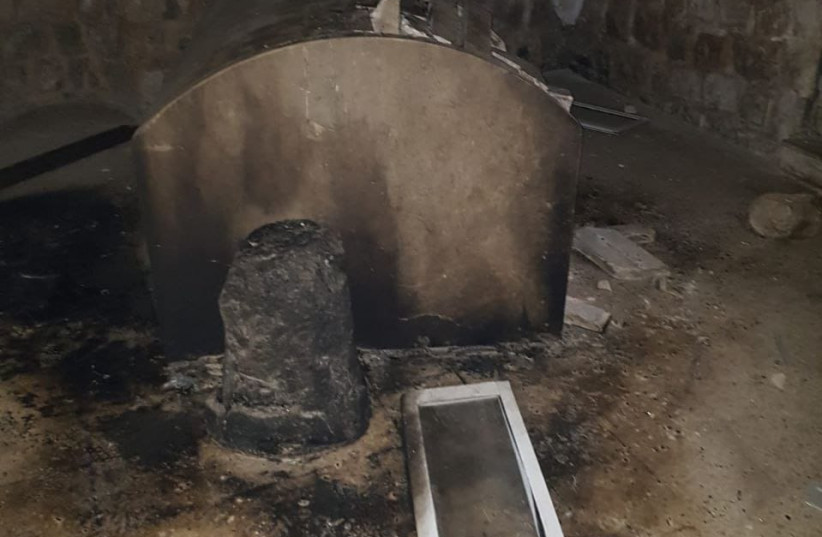During the night between April 9 and 10, 2022, dozens of Palestinian rioters in Nablus (Shechem) raided and vandalized the Jewish holy site known as the biblical Tomb of Joseph. The rioters set fire to the site, smashed the cenotaph above the grave, smashed electrical lighting, burned prayer books, and ruined and burned equipment within the tomb area. On April 11, it was discovered that the rioters had returned to destroy whatever they had missed during the previous night.
Similar attacks have taken place in the past. In 2000 rioting, an Israeli policeman, Madhat Yussef, was shot and bled to death over the hours the Palestinian Authority denied entry to Israeli medical personnel. In 2015, the site was again seriously damaged by arson committed by Palestinian rioters.
<br>Religious significance
According to biblical tradition and the writings of historians from time immemorial, the tomb is located in the city of Shechem in the West Bank area of Judea and Samaria.
Since the city of Nablus is located within the Palestinian-populated Area A, as defined in the Israeli-Palestinian Interim Agreement (1995), commonly known as Oslo 2, it is under the full control and jurisdiction of the Palestinian Authority.
The holiness of Joseph’s Tomb stems from the reference in the Old Testament’s book of Joshua 24:32:
“And Joseph’s bones, which the Israelites had brought up from Egypt, were buried at Shechem in the tract of land that Jacob bought for a hundred pieces of silver from the sons of Hamor, the father of Shechem. This became the inheritance of Joseph’s descendants.”

Historical and biblical references to the tomb, including pilgrim accounts and scholarship, confirm its location in the Nablus area.
In light of the religious importance, centrality, and sensitivity of all holy sites to both Palestinians and Israelis, whether these are tombs, graves, places of worship or other related holy places, and whether they be Jewish, Muslim, Christian, Druze, Baha’i, Samaritan or other – they are all revered and respected, and enjoy protected status by the parties.
<br>Legal status, obligations relating to Joseph’s Tomb
The status of Joseph’s Tomb and the responsibility of the Palestinian Authority to protect it and those visiting it was agreed upon in the 1995 Israeli-Palestinian Interim Agreement, which specifically lists the Tomb as a Jewish holy site in its fourth appendix, together with the Shalom Al Israel Synagogue in Jericho.
In the Protocol attached as Annex I to the Interim Agreement concerning “Redeployment and Security Arrangements,” Article V, paragraph 2 provides that “the protection of [Jewish holy sites], as well as of persons visiting them, will be under the responsibility of the Palestinian Police.”
This overall Palestinian responsibility is, according to the agreement, to be maintained and supervised by Joint Mobile Units composed of vehicles driven by Palestinian police and by Israeli security forces, whose task, according to the same article, is to provide rapid response in the event of incidents and emergency situations, to ensure free, unimpeded, and secure access to the relevant Jewish holy site, to ensure the peaceful use of such site, to prevent any potential instances of disorder and to respond to any incident.
The agreement also provides, in subparagraph (c) of Article V (2), that “Given their Jewish religious nature, plainclothes Israeli guards may be present inside such sites.”
It appears that since 2000, following the murder of the Israeli policeman Madhat Yussef on duty in Joseph’s Tomb, the provisions of the Interim Agreement regarding Joint Mobile Units and rapid response to incidents and emergency situations are not being implemented.
However, specific periodic visits to the tomb are coordinated between the respective security authorities as part of the security cooperation between them, with a view to ensuring safety and prevention of violent incidents.
Given the acute sensitivity attributed by both Palestinians and Israelis to all religious sites, and in light of the unique religious significance of the current period during which the Muslim holy month of Ramadan, the Jewish festival of Passover, and the Christian festival of Easter all occur together, it is all the more incumbent upon the Palestinian leadership to fulfill their responsibilities as agreed in the Oslo Accords, and to prevent such vandalizing and desecration of a Jewish or any holy site under their authority.
The repeated assaults on religious sites which the PA is supposed to prevent strongly suggests that the responsibility for protecting them must remain with Israel and not be turned over to a Palestinian governmental body, which cannot be relied upon, as has been proven on repeated occasions.
The writer is director of the Institute for Contemporary Affairs at the Jerusalem Center and the head of the Global Law Forum. He participated in the negotiation and drafting of the Oslo Accords with the Palestinians, as well as agreements and peace treaties with Egypt, Jordan and Lebanon.
